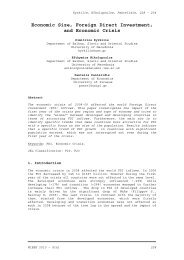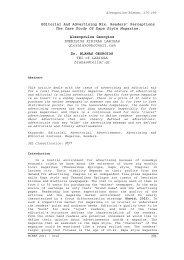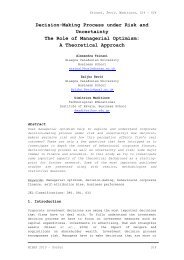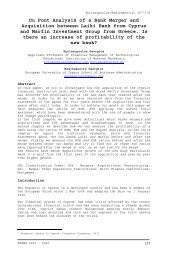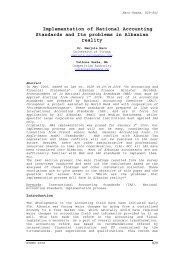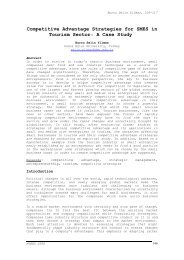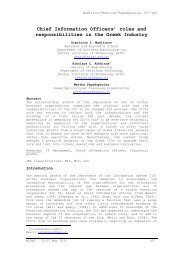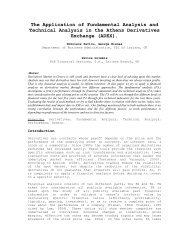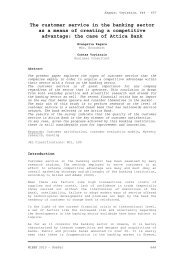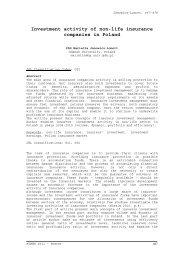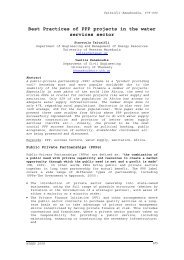Financial Analysis of Business Plan - mibes
Financial Analysis of Business Plan - mibes
Financial Analysis of Business Plan - mibes
Create successful ePaper yourself
Turn your PDF publications into a flip-book with our unique Google optimized e-Paper software.
MIBES 2011 – Poster<br />
Maslauskaite-Koumpis, 479-493<br />
Return on investment (ROI). According to Helfert (2001), it states the<br />
desirability <strong>of</strong> an investment in terms <strong>of</strong> a percentage return on the<br />
original outlay. A performance measure used to evaluate the efficiency<br />
<strong>of</strong> an investment or to compare the efficiency <strong>of</strong> a number <strong>of</strong> different<br />
investments. To calculate ROI, the benefit (return) <strong>of</strong> an investment<br />
is divided by the cost <strong>of</strong> the investment; the result is expressed as a<br />
percentage or a ratio.<br />
Average annual operating cash flow<br />
ROI =<br />
Net investment<br />
At the above formula (2) “gains from investment”, refers to the<br />
proceeds obtained from selling the investment <strong>of</strong> interest. That is, if<br />
an investment does not have a positive ROI, or if there are other<br />
opportunities with a higher ROI, then the investment should be not be<br />
undertaken.<br />
This is one <strong>of</strong> possible business investment analysis. It is as the<br />
process <strong>of</strong> weighing the economic trade-<strong>of</strong>f between current money value<br />
outlays and future net cash flow benefits that are expected to be<br />
obtained over a relevant period <strong>of</strong> time (Helfert, 2001).<br />
1. 3. Scenario<br />
The origins <strong>of</strong> scenario show how definition and understanding <strong>of</strong><br />
scenario meaning was changing. “The concept <strong>of</strong> using alternative<br />
scenarios for institutional planning was popularized by Kahn and<br />
Wiener in writings about “surprise-free” futures. It had been Herman<br />
Kahn who introduced the word “scenario” into the planner’s vocabulary<br />
while at RAND Corporation in the 1950s. The term was used in<br />
connection with military and strategic studies conducted by RAND for<br />
the government; it appeared in the “open” literature in the text <strong>of</strong><br />
the Kahn and Wiener book “The Year 2000” in the late 1960s. In that<br />
publication, “scenarios” were defined as hypothetical sequences <strong>of</strong><br />
events constructed for the purpose <strong>of</strong> focusing attention on causal<br />
processes and decision points” (Zentner, 1982, pg. 14).<br />
According to Chermack (2002), there are a large number <strong>of</strong> different<br />
and at times conflicting definitions, characteristics, principles and<br />
methodological ideas about scenarios. “The process <strong>of</strong> scenario<br />
planning is relatively young, and many variations have been developed.<br />
This variety <strong>of</strong> approaches can also be found in the available<br />
definitions and espoused dependent or outcome variables <strong>of</strong> scenario<br />
planning” (Chermack, 2002) (see Appendix).<br />
According to Chermack (2002), all gathered available definitions <strong>of</strong><br />
scenario planning summarize, analyze and collapse it into “four major<br />
outcome categories <strong>of</strong> scenario planning:<br />
changed thinking,<br />
informed narratives or stories about possible or plausible<br />
futures,<br />
improved decision making about the future,<br />
enhanced human and organization learning and imagination”<br />
(Chermack, 2002, pg. 373).<br />
Zentner article which was written in 1982 and the literature review<br />
made by Chermack in 2002 show that scenario planning is about possible<br />
( 2);<br />
484



